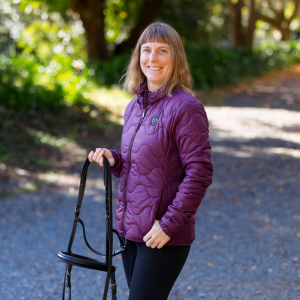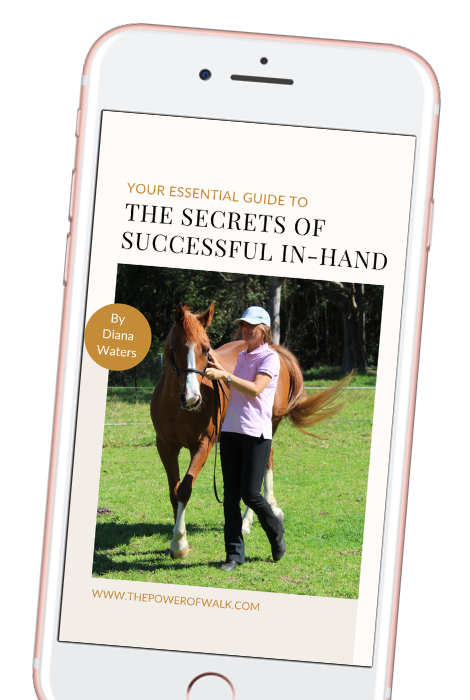I made up a word: PANANAA!
made up a word: PANANAA! The Power of Asking from Nothing and Asking Nothing After the Ask!
I do not enjoy having to drive, hold or apply repeated aids constantly. I do not think the horse enjoys it either. I also feel it’s rather a waste of energy.
I learned a lot when I trained as an instructor, and some of this was valuable about how to do things. Some of it was also valuable as information about how I do not want to do things!
I was taught, when training as an instructor: on a 20m circle, if the horse is falling in, use more inside leg to outside rein. If my legs are strong and effective, and my hands are steady and consistent, I can sort of “pop” the horse into the correct bend. However, he or she doesn’t stay there by themself. If I remove the inside leg and soften the outside rein, the horse goes back to falling in. So, I would keep them there with my strong inside leg to outside hand. By the end of the lesson, we had achieved several “correct” circles with “correct” bend, but my inside leg, and no doubt the horse’s inside ribcage, as well as other parts of his or her body, were aching.
I was taught to “ride forward from leg to hand”, and to keep applying leg aids and holding with the hands, every stride. If the horse was not forward enough, “more leg”.
Riding, I was taught, is “no pain no gain” and you need to be physically very strong and fit to “hold together” these big animals.
I was taught, when lungeing during my instructor training, to drive the horse forward continually, and to make sure I was talking to the horse continually and moving the whip continually to maintain forward rhythm. This keeps everything looking neat, tidy and rhythmical, but….
It is commonplace to see horses that will only move very slowly, or not at all, unless you spur them on every step, or continually wave a whip at them. But wait.. this is not actually how it seems...
If you have a “slow” horse, try this: Ask your horse to walk. (either riding, lungeing or leading). Now, soften the hands take off the legs/quieten the lunge whip and voice, and see what happens. ( I know it takes willpower, but try to ignore Bertha Busybody leaning over the fence saying “For goodness sake, get that horse moving!”)
If you can have the willpower to continue to do nothing, it is fascinating what unravels. Sometimes, the horse will halt, in which case, you quietly ask him to walk again, and then continue to do nothing. Usually the horse proceeds in a tentative, very hesitant and slow walk, waiting to see what you are playing at. Sit and frame this walk by sitting straight and in balance and synchronising perfectly with whatever movement is offered, and breathing. Or, if on the ground, just keep the whip quiet, tune into the horse, match his or her energy, and stay grounded and breathing.
If you can have the willpower to let go of all expectation, other than for the horse to walk on again when you ask, if he or she halts, you will begin to learn something very special about your horse. You will literally feel him begin to untangle and unravel, and move more freely, at first tentative and unsure, but soon gathering confidence. (Sometimes straightaway, sometimes much more gradually).
This initial step is so important in beginning to introduce mindful directions to a responsive and receptive horse. If you can cut out all of the noise and nagging and allow the horse to breathe and have space, you will very quickly feel a big shift in energy. Your horse will quickly begin to find his or her “forward”.
Start from nothing. Then add only the things you need. Usually the first step after “nothing” is “straighten” but very different from my original instructor learning: now the horse has relaxed into connection with the trainer, he or she will allow us to suggest one little change to his or her body positioning at a time. It’s clear what we are asking. Much lighter, and much clearer now the noise has gone. “Feel this touch on your neck: can you soften this muscle?” Or “feel this rein aid: can you turn your head and shoulders just a fraction in this direction? It’s OK if you need to hesitate or slow down, or take a few steps to process”.
In the original story, there were so many asks at once. “Go faster, do this with your ribs and this with your head and neck. Not too fast!!”
Or the trainer says “Go faster. Faster. Faster. Keep going. Keep going. Keep going.” While the horse is saying “I’m locked up and crooked and it’s hard to balance and I can’t figure out how to arrange my body or process what you are asking.”
The first skill is to become comfortable with asking nothing. The second skill is to ask once, for one thing, allow the horse time to process and then leave him alone for you both to experience the result. Do not be attached to maintaining anything.
If your horse walks really slow, or loses rhythm, that is not an issue at all. In fact, it is to be expected because now he or she is responsible for their own balance, they will be wobbly at first, and experiencing the wobbles is the first step towards making changes. If you push through to even up the rhythm, there is a good chance they will just return to old compensation patterns. If your horse stops and refuses to move altogether, then there is a bigger issue, and that issue is not ever going to be resolved by pushing him or her on, or increasing aids. Quite possibly he or she has become completely switched off by all the nagging, and mentally left his or her body. He or she may not even be able to feel your aids through not being present. This horse, more than ever, needs to be taken right back down to nothing, with patience and creativity around finding new ways to motivate him or her and make them feel safe.
Good training can and should always look beautiful, from day 1. The trainer has calm energy and appears to do very little. Of course nobody is perfect and there will be days when it doesn’t work out like this. But, those are mistakes and not the aim of the game.
This slow, focused work can and should be brief, and mixed up with joyful trail riding or fun cantering, and loose rein walking, with no correction at all. The horse needs opportunities to move with complete freedom and no correction.
Video: The very first step – to walk with the horse, breathe, connect, and ask nothing. When the horse hesitates, I wait for her. When I feel her reconnecting we walk. When she becomes distracted, turns her head away and begins to stop, I don’t pull her head back, or push on to maintain rhythm, but slow to match her steps – so I stay with her, then I suggest, with my own steps, that we continue rather than stop. By the end, she realises that walking with me feels safe and you see a subtle increase in her focus as she relaxes her neck forward, straight and down, and steps into rhythm.



